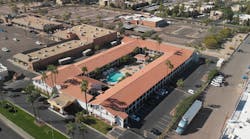14 'extreme' glass systems
Our roundup of glazing technologies includes blast-resistant, fire-rated, dynamic, and other specialty solutions.
1. USER-CONTROLLED PRIVACY CREATED WITH SWITCHABLE GLASS
LC Privacy Glass is an electrically activated, user-switchable glazing technology that instantly changes from transparent to frosted white—providing control of light, glare, heat gain, and privacy. Manufacturer Innovative Glass suggests the UL-approved product for applications such as conference rooms, where it creates privacy for meetings while allowing light to pass through. LC Privacy Glass eliminates the need for mechanical shades, blinds, or other window coverings. Available options include 5/16-, 7/16-, and 9/16-inch thicknesses, as well as IGUs.
Innovative Glass Corp.
2. DIGITAL PRINTING TECHNOLOGY ALLOWS ARTISTIC EXPRESSIONS IN GLASS
DigitalDistinctions by Viracon is a digital printing solution that enables building designers to print glass façades with custom images. The process combines durable ceramic inks with digital printing, enabling a vast selection of colors to be applied to a single lite and allowing production of high-resolution pictures, drawings, patterns, text, and textures. The printed glass is UV-resistant, scratch-resistant, and light-transmissive. The manufacturer’s solar-control coatings can be applied directly over the digital image. For additional versatility, designers can specify either clear or tinted glass substrates.
Viracon
Viracon
3. BODY-TINTED SOLAR-CONTROL GLASS AVAILABLE IN MULTIPLE COLORS
Optifloat solar-control glass, by Pilkington, is available in green, bronze, gray, blue-green, and the new graphite blue tint. Available options include thicknesses ranging from 3mm to 12mm (depending on color), and Solar-E Plus pyrolytic coating. The coating process adds durability and inhibits degradation, according to the manufacturer. Reflectivity is designed to be low, reducing uncomfortable glare and improving privacy compared with clear glass. To achieve optimal thermal insulation, Optifloat can be combined with the manufacturer’s Energy Advantage low-e glass in an IGU. The manufacturer suggests the product for applications that demand solar control without the use of surface coating, including healthcare, academic, office, and retail facilities.
Pilkington North America
Pilkington North America
4. DYNAMIC GLASS HELPS UNIVERSITY ACHIEVE SUSTAINABILITY GOALS
When Colorado State University decided to expand its Morgan Library with a student study space, it asked architect Studiotrope to aim for a minimum of LEED Silver certification. Studiotrope employed several high-tech glazing technologies for the sleek cube, including dynamic SageGlass from SAGE Electrochromics. This electronically tintable glass maximizes daylight and views while controlling heat gain and glare and reducing energy consumption. Tinting can be controlled manually or with a building automation system. SageGlass is installed in the two-story western curtain wall of the addition, including several operable windows and an egress door. Glass on the two floors can be controlled separately and activated by exterior light sensors. Preserving the view to the surrounding campus and ensuring student comfort were two key design objectives that were met by installing the product.
SAGE Electrochromics
SAGE Electrochromics
5. ALUMINUM WINDOWS COMBINE BLAST RESISTANCE, EFFICIENCY
The new Peerless Energsave G-500 blast aluminum windows feature a U-value of 0.15. The design is engineered for lower heat flow and reduced air leakage while meeting DoD Standard UFC 4-010-01, Minimum Antiterrorism Standards for Buildings. The window is anchored inward to allow the product to flex, absorbing energy and preventing transfer to the wall, for increased structural integrity. Units are anchored only at the head and sill, and feature integral blast trim and optional pre-drilled holes to simplify installation. Energy-efficiency features include integral aluminum bars within the thermal break, low-e foil on each side of the break, and neoprene foam above and below the break.
Peerless Architectural Windows and Doors
Peerless Architectural Windows and Doors
6. SOLAR INTERLAYER TECHNOLOGY VARIES TINTING WITH THE SUN
Suntuitive, by Pleotint, is a new interlayer designed to be laminated between panes of window glass. The patented polyvinyl butyral layer lightens and darkens without mechanical intervention, according to changing ambient temperatures and sunlight. Laminated construction provides the strategic benefits of a safety-laminated window and attenuates external noise, according to the manufacturer. In addition, laminated windows, such as those including Suntuitive, tend to be more resistant to breakage and impact.
Pleotint
Pleotint
7. HEALTHCARE FACILITY BENEFITS FROM FIRE-RATED CURTAIN WALL
To give patients in the 357,000-sf MultiCare Good Samaritan Dally Tower, Puyallup, Wash., ample access to natural light, the Building Team included a skylit central glass elevator. Architects Good Sam Design Collaborative, Clark/Kjos Architects, and GBJ Architecture chose the Fireframes Curtainwall Series to meet applicable codes while maintaining daylighting. Fireframes combines fire-rated frames with Pilkington Pyrostop glass, protecting against radiant and conductive heat transfer and allowing unlimited areas of glazing in fire separations. The UL-listed system carries fire ratings up to two hours as a wall assembly when used in conjunction with Pyrostop glass. The daylighting plan helped Dally Tower achieve LEED Gold status.
8. ETCHED GLASS PRODUCTS HELP PREVENT BIRD COLLISIONS
Walker Textures AviProtek, a new acid-etched glass product line, was designed for bird-safe building design. AviProtect includes three designs, as well as an overall acid-etched product. When used on the Number 1 surface, the glass has a threat factor rating from 5 to 29.8, responding to LEED pilot credit 55, Bird Collision Deterrence. Patterns meet the 2x4 rule, which states that most birds won’t fly into surfaces that have two inches or less of untreated horizontal space, or four inches or less of untreated vertical space. According to the manufacturer, acid etching has no significant effect on visible light transmittance and may work better for deterrence than internal fritted patterns, which may be invisible to birds due to exterior reflections.
Walker Glass
Walker Glass
9. PSYCHIATRIC-GRADE WINDOWS ADD SECURITY, APPEAL TO HISTORIC HOSPITAL
Vermont’s Brattleboro Retreat, a psychiatric hospital and addiction-treatment center, recently completed an extensive remodeling project that included Wausau’s 4000i_DT Series psychiatric-grade windows. Founded in 1834, the facility is undertaking a $12 million improvement program, including evaluations of existing double-hung windows. Replacement windows for the Osgood Building were manufactured with applied muntin grids and complementary panning and trim. The windows are drop-tested for interior human impacts of up to 2,000 foot-pounds, keeping patients safe while admitting ample light. Integral between-glass blinds were combined with IGUs from Viracon to optimize thermal performance and control heat gain. On the Building Team: Lavallee Brensinger (architect), Greenfield Glass (glazing contractor), and Engleberth Construction (GC).
Wausau Window and Wall Systems
Wausau Window and Wall Systems
10. BLAST-RESISTANT IGUs SUIT NEEDS OF FEDERAL RENOVATION
For a recent renovation of the 35-story Henry M. Jackson Building in Seattle, the Building Team specified 3,500 double-pane, argon-filled IGUs with bronze Solarban 70XL solar-control, low-e glass. The glass was placed on the No. 2 surface, replacing quarter-inch single-pane windows. On the first 20 floors, extra protection was provided with an interior lite of 6mm clear, blast-resistant laminated glass, plus a 0.03-inch clear Saflex interlayer. Higher floors received interior lites of 6mm clear glass along with the Solarban 70XL. On the Building Team: Bassetti Architects and glazing contractor Walters & Wolf.
PPG Industries
PPG Industries
11. RIGOROUS CURTAIN WALL TESTING AFFIRMS WEATHER AND BLAST RESISTANCE
The new 1630 SS IR curtain wall has been extensively tested for hurricane resistance and blast-mitigation characteristics, ensuring compliance with the Florida Building Code and Miami-Dade’s Notice of Acceptance criteria, as well as the more stringent Level E (enhanced facilities) requirements. An extensive evaluation using numerous ASTM and TAS protocols encompassed large- and small-missile impacts and affirmed likely performance in high winds, heavy rains, and hurricanes, as well as compliance with stringent DoD and Interagency Security Committee/GSA requirements for blast performance. Wet (silicone) glazed and dry-glazed options are available, and both have been tested up to a 130-psf design load. The screw spline fabrication system features interlocking mullions, speeding installation and eliminating the need to install anti-buckling clips.
Kawneer North America
Kawneer North America
12. GLAZING ADDS EFFICIENCY TO WORLD’S TALLEST BUILDING
Building a skyscraper in the desert requires a high-performance glass product that can withstand the harshest conditions. Architect Skidmore, Owings & Merrill selected Guardian SunGuard Solar Silver 20 and ClimaGuard NLT low-e glass for the 2,650-foot Burj Khalifa in Dubai. This building must stand up to extreme winds that are known to be gusty and unpredictable. In addition, the wind pressure changes at different levels of the Burj, so different glass thicknesses were required. The glazing also must withstand desert temperature swings, and was selected to provide an anti-glare shield from the sun. The high light reflectance helps keep the interior from overheating. Nearly two million square feet of SunGuard Solar Silver and ClimaGuard NLT low-e was used on the project, with the largest panes measuring about 6x10 feet.
Guardian Industries
Guardian Industries
13. ARCHITECTURAL DYNAMIC GLASS GIVES USERS FLEXIBILITY, CONTROL
View Inc.’s user-controlled dynamic glass products are tintable in response to external conditions. Users can program windows for specific conditions and change the shade level on command. Heat, light, and glare can be managed while maintaining views and reducing energy consumption. Depending on tint level, heat gain coefficients range from 0.45 to 0.09, and transmitted light ranges from 58% to 3%. Dynamic technology allows Building Teams to use more glass while meeting code and energy-efficiency goals, as well as reducing or eliminating the need for blinds and shading structures. According to the manufacturer, the product is especially suitable for hospitals, hotels striving to improve guest experiences and reduce operating costs, and owner-occupied corporate offices.
View Inc.
View Inc.
14. CURTAIN WALL SYSTEM PROTECTS OCCUPANTS
The Building Team for The Kensington, a mixed-use residential project in Boston, turned to a fire-rated system for part of the project’s curtain wall. Because the building is close to the property line, local authorities required some of the wall to meet ASTM E-119/NFPA 251/UL263 for 60 minutes. The selected curtain wall needed to match the adjoining non-rated systems and pass rigorous dynamic testing, as specified by architect TAT. SAFTI FIRST supplied SuperLite II-XL 60 insulated with Solarban 70XL in SAFTIfire CW framing, creating a continuous span from the seventh to tenth floors. Mimicking the appearance of an aluminum pressure wall, the system matched the non-rated exterior glazing while meeting an average U value of no more than 0.40, and an SHGC no greater than 0.25. The system passed independent testing for air leakage, water resistance, structural and seismic performance.
SAFTI FIRST
SAFTI FIRST
















